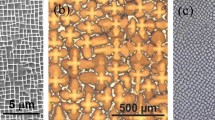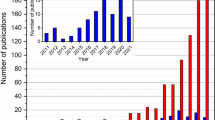Abstract
The recent advances in additive manufacturing (AM) have led to printing of complex structural components. The highly non-equilibrium processing conditions encountered during direct metal laser melting (DMLM) frequently lead to micro-cracking in high-temperature capable Ni-superalloys, irrespective of processing conditions, limiting their current applicability. This paper aims to develop a general criterion to assess printability of a Ni-superalloy solely based on its composition. Thirty-four Ni-superalloys spanning a wide range of alloying elements were printed, each with twenty-four process conditions, and their crack densities were measured in order to have a consistent set of experimental data for building a model. The models available in literature for predicting cracking susceptibility were evaluated against the experimental data. Finally, a hybrid model, based on physics-based quantities, was built with the most significant input features (x’s). This model correlates well with the experimental data and is applicable across a wide range of Ni-superalloy compositions.
Access this chapter
Tax calculation will be finalised at checkout
Purchases are for personal use only
Similar content being viewed by others
References
J. Zhang and R. F. Singer, “Hot tearing of nickel-based superalloys during directional solidification,” Acta Materialia, vol. 50, no. 7, pp. 1869–79, 2002.
K. Aggour, V. Gupta, D. Ruscitto, L. Ajdelsztajn, X. Bian, K. Brosnan, … and J. Vinciquerra, “Artificial intelligence/machine learning in manufacturing and inspection: A GE perspective,” MRS Bulletin, vol. 44, no. 7, pp. 545–558, 2019.
G. Cam and M. Kocak, “Progress in Joining of Advanced Materials,” International Materials Reviews, vol. 43, no. 1, pp. 1–44, 1998.
T. Clyne and G. Davies, “Comparison between experimental data and theoretical predictions relating to dependence of solidification cracking on composition,” in Solidification and Casting of Metals, Metals Society, London, 1979.
D. D. Gu, W. Meiners, K. Wissenbach and R. Poprawe, “Laser additive manufacturing of metallic components: materials, processes and mechanisms,” International Materials Reviews, vol. 57, no. 3, pp. 133–164, 2012.
M. B. Henderson, D. Arrell, M. Heobel, R. Larsson and G. Marchant, “Nickel based superalloy welding practices for industrial gas turbine applications,” Science and Technology of Welding and Joining, vol. 9, no. 1, pp. 13–21, 2004.
C. Körner, “Additive manufacturing of metallic components by selective electron beam melting — a review,” International Materials Reviews, vol. 61, no. 5, pp. 361–377, 2016.
S. Kou, “A criterion for cracking during solidification,” Acta Materialia, vol. 88, pp. 366–374, 2015.
M. Rappaz, H.-M. Drezet and M. Gremaud, “A new hot-tearing criterion,” Metallurgical and Materials Transactions A, vol. 30, pp. 449–455, 1999.
W. J. Sames, F. A. List, S. Pannala, R. R. Dehoff and S. S. Hoff, “The metallurgy and processing science of metal additive manufacturing,” International Materials Reviews, vol. 61, no. 5, pp. 315–316, 2016.
B. B. Seth, “Superalloys-The Utility Gas Turbine Perspective,” in Superalloys 2000, TMS, Seven Springs, PA, USA, 2000.
ThermoCalc Software, TCNI8/Superalloy databaase, www.thermocalc.com.
R. Engeli, T. Etter, S. Hövel and K. Wegener, “Processability of different IN738LC powder batches by selective laser melting,” Journal of Materials Processing Technology, vol. 29, pp. 484–491, 2016.
D. Tomus, P. A. Rometsch, M. Heilmaier and X. Wu, “Effect of minor alloying elements on crack-formation characteristics of Hastelloy-X manufactured by selective laser melting,” Additive Manufacturing, vol. 16, pp. 65–72, 2017.
E. Chauvet, P. Kontis, E. A. Jagle, B. Gault, D. Raabe, C. Tassin, J.-J. Blandin, R. Dendievel, B. Vayre, S. Abed and G. Martin, “Hot cracking mechanism affecting a non-weldable Ni-based superalloy produced by selective electron Beam Melting,” Acta Materialia, vol. 142, pp. 82–94, 2018.
M. Cloots, P.. J. Uggowitzer and K. Wegener, “Investigations on the microstructure and crack formation of IN738LC samples processed by selective laser melting using Gaussian and doughnut profiles,” Materials and Design, vol. 89, pp. 770–784, 2016.
M. L. Montero-Sistiaga, S. Pourbabak, J. V. Humbeeck, D. Schryvers and K. Vanmeensel, “Microstructure and mechanical properties of Hastelloy X produced by HP-SLM (high power selective laser melting),” Materials and Design, vol. 165, p. 107598, 2019.
Q. Han, R. Mertens, M. L. Montero-Sistiaga, S. Yang, R. Setchi, K. Vanmeensel, B. V. Hooreweder and S. L. Evans, “Laser powder bed fusion of Hastelloy X: Effects of hot isostatic pressing and the hot cracking mechanism,” Materials Science & Engineering A, vol. 732, pp. 228–239, 2018.
M. C. Flemings, in Solidification Processing, New York, McGraw-Hill, 1974, p. 254.
T. DebRoy, H. L. Wei, J. S. Zuback, T. Mukherjee, J. W. Elmer, J. O. Milewski and A. M. Beese, “Additive manufacturing of metallic components – Process, structure and properties,” Progress in Materials Science, vol. 92, p. 112–224, 2018.
T. Mukherjee, J. S. Zuback, A. De and T. DebRoy, “Printability of alloys for additive manufacturing,” Scientific Reports, vol. 6:19717, 2016.
Y. Mishima, S. Ochiai, N. Hamao, M. Yodogawa and T. Suzuki, “Solid Solution Hardening of Nickel- Role of Transition Metal and B-subgroup Solutes,” Transactions of the Japan Institute of Metals, vol. 27, no. 9, pp. 656–664, 1986.
Acknowledgements
The authors acknowledge the additive manufacturing and materials characterization teams at GE Research for experimental builds and defect quantification, as well as Dr. Timothy Hanlon from GE Research and Dr. Debashis Kar from GE Aviation for helpful technical discussion. Funding from the additive platform of GE Research (Joseph Vinciquerra, Dr. Steve Duclos,) is gratefully acknowledged.
Author information
Authors and Affiliations
Corresponding author
Editor information
Editors and Affiliations
Rights and permissions
Copyright information
© 2020 The Minerals, Metals & Materials Society
About this paper
Cite this paper
Shukla, A., Sarkar, S., Durga, A., Adharapurapu, R., Dial, L., Sondhi, S.K. (2020). Computational Design of Additively Printable Nickel Superalloys. In: Tin, S., et al. Superalloys 2020. The Minerals, Metals & Materials Series. Springer, Cham. https://doi.org/10.1007/978-3-030-51834-9_104
Download citation
DOI: https://doi.org/10.1007/978-3-030-51834-9_104
Published:
Publisher Name: Springer, Cham
Print ISBN: 978-3-030-51833-2
Online ISBN: 978-3-030-51834-9
eBook Packages: Chemistry and Materials ScienceChemistry and Material Science (R0)




